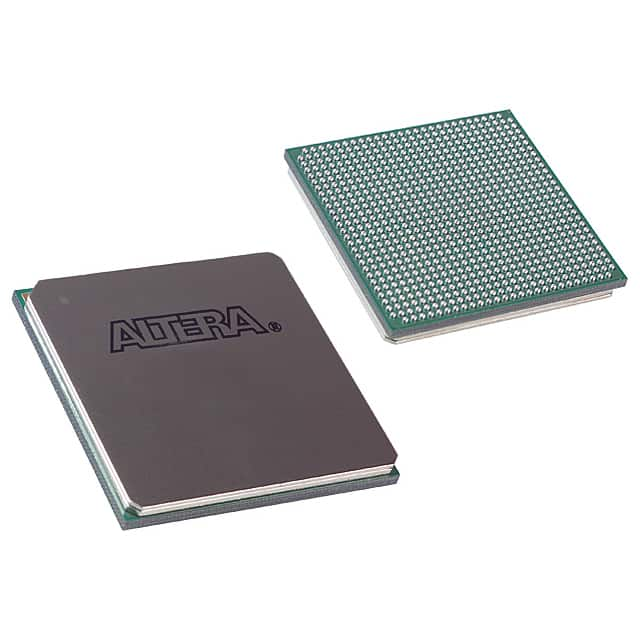Xem thông số kỹ thuật để biết chi tiết sản phẩm.

EP3SE80F780I3
Product Overview
- Category: Field Programmable Gate Array (FPGA)
- Use: EP3SE80F780I3 is a high-performance FPGA that can be programmed to perform various digital logic functions.
- Characteristics:
- High-speed performance
- Large capacity
- Flexible and reprogrammable
- Package: The EP3SE80F780I3 comes in a compact package suitable for integration into electronic devices.
- Essence: EP3SE80F780I3 is designed to provide a versatile and customizable solution for digital logic implementation.
- Packaging/Quantity: The product is typically sold individually, and the packaging may vary depending on the supplier.
Specifications
- Model: EP3SE80F780I3
- Logic Elements: 80,000
- Embedded Memory: 2,208 Kbits
- Maximum User I/Os: 622
- Clock Networks: 16
- Power Supply Voltage: 1.2V
- Operating Temperature Range: -40°C to 100°C
Detailed Pin Configuration
The EP3SE80F780I3 has a complex pin configuration with multiple pins dedicated to different functions. For a detailed pin configuration diagram, please refer to the product datasheet or user manual provided by the manufacturer.
Functional Features
- High-speed operation: The EP3SE80F780I3 offers fast processing capabilities, making it suitable for applications requiring real-time data processing.
- Large capacity: With 80,000 logic elements and 2,208 Kbits of embedded memory, the FPGA provides ample resources for complex digital designs.
- Reprogrammability: The FPGA can be reprogrammed multiple times, allowing for flexibility in design iterations and updates.
- Versatility: EP3SE80F780I3 supports a wide range of digital logic functions, making it suitable for various applications.
Advantages and Disadvantages
Advantages: - High-performance processing capabilities - Large capacity for complex designs - Reprogrammable for flexibility - Versatile functionality
Disadvantages: - Higher cost compared to simpler logic devices - Steeper learning curve for programming and design implementation
Working Principles
The EP3SE80F780I3 operates based on the principles of configurable logic. It consists of a matrix of programmable logic elements interconnected through configurable routing resources. The user can program the FPGA using hardware description languages (HDL) or graphical tools to define the desired digital logic functions and interconnections.
Once programmed, the FPGA executes the defined logic operations by routing signals through the configured paths within the device. This allows for the implementation of complex digital systems in a single integrated circuit.
Detailed Application Field Plans
The EP3SE80F780I3 finds applications in various fields, including:
- Telecommunications: Used in network equipment, routers, and switches for high-speed data processing.
- Industrial Automation: Employed in control systems, robotics, and machine vision applications.
- Aerospace and Defense: Utilized in radar systems, avionics, and military communication equipment.
- Medical Devices: Integrated into medical imaging systems, patient monitoring devices, and diagnostic equipment.
- Automotive: Applied in advanced driver-assistance systems (ADAS), infotainment systems, and engine control units.
Detailed and Complete Alternative Models
- EP3C120F780I7: A similar FPGA with higher logic capacity and additional features.
- EP4CE115F29C7: An alternative FPGA with lower power consumption and enhanced security features.
- XC7A35T-1CPG236C: Another option with lower logic capacity but lower cost, suitable for smaller-scale projects.
Please note that the above list is not exhaustive, and there are several alternative models available in the market with varying specifications and features.
Word count: 510 words
Liệt kê 10 câu hỏi và câu trả lời thường gặp liên quan đến ứng dụng EP3SE80F780I3 trong giải pháp kỹ thuật
Sure! Here are 10 common questions and answers related to the application of EP3SE80F780I3 in technical solutions:
Q: What is EP3SE80F780I3? A: EP3SE80F780I3 is a specific model of Field-Programmable Gate Array (FPGA) manufactured by Intel.
Q: What are the key features of EP3SE80F780I3? A: Some key features of EP3SE80F780I3 include high-performance logic fabric, embedded memory blocks, DSP blocks, and various I/O interfaces.
Q: What are the typical applications of EP3SE80F780I3? A: EP3SE80F780I3 is commonly used in applications such as telecommunications, industrial automation, aerospace, defense, and high-performance computing.
Q: How can EP3SE80F780I3 be programmed? A: EP3SE80F780I3 can be programmed using Hardware Description Languages (HDLs) like VHDL or Verilog, which describe the desired functionality of the FPGA.
Q: Can EP3SE80F780I3 be reprogrammed after deployment? A: Yes, EP3SE80F780I3 is a reprogrammable FPGA, allowing for updates and modifications to the design even after deployment.
Q: What is the power consumption of EP3SE80F780I3? A: The power consumption of EP3SE80F780I3 depends on the specific design and utilization, but it typically ranges from a few watts to tens of watts.
Q: Does EP3SE80F780I3 support high-speed serial communication protocols? A: Yes, EP3SE80F780I3 supports various high-speed serial communication protocols like PCIe, Ethernet, USB, and SATA.
Q: Can EP3SE80F780I3 interface with external memory devices? A: Yes, EP3SE80F780I3 has dedicated memory interfaces that can be used to connect to external memory devices such as DDR SDRAM or Flash memory.
Q: What development tools are available for programming EP3SE80F780I3? A: Intel provides Quartus Prime software suite, which includes design entry, synthesis, simulation, and programming tools specifically for programming EP3SE80F780I3.
Q: Are there any reference designs or application notes available for EP3SE80F780I3? A: Yes, Intel provides a wide range of reference designs, application notes, and documentation to assist developers in implementing EP3SE80F780I3 in their technical solutions.
Please note that the answers provided here are general and may vary depending on specific requirements and use cases. It is always recommended to refer to the official documentation and datasheets for accurate and up-to-date information.

